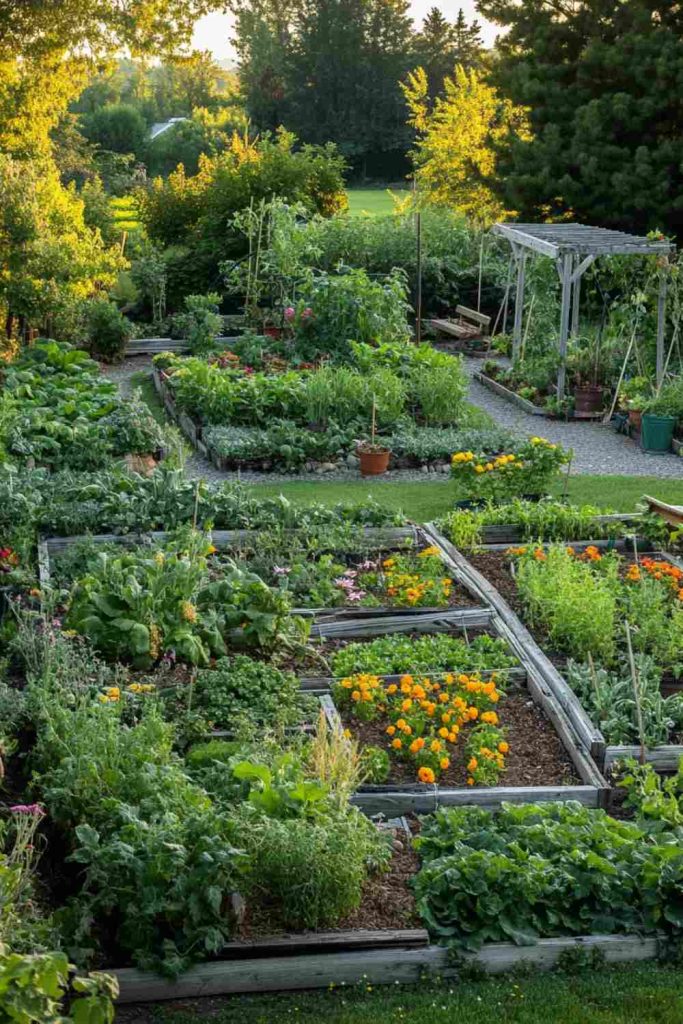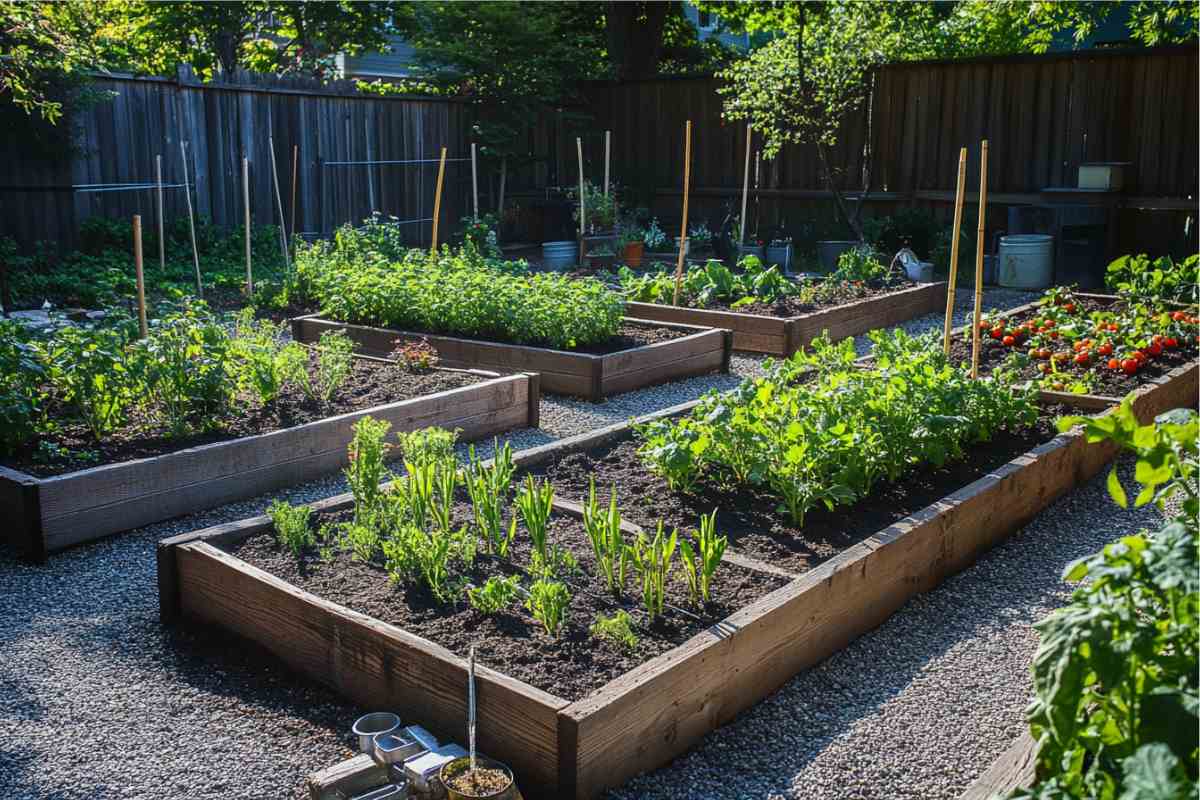Most beginner gardens fall short for just two reasons: poorly matched plants and inefficient use of space. A thoughtful layout eliminates both problems. It also boosts curb appeal (up to 15 % in U.S. real‑estate studies), cuts water use, and if you grow edibles it can shave hundreds off your grocery bill each season. Think of your plan as a blueprint that pays dividends for years.
1. Setting Your Goals & Priorities
Determine the Garden’s Primary Function
Before measuring a single line, clarify what success looks like for you:
| Goal | Space Needed | Typical Yield/Benefit |
|---|---|---|
| Kitchen produce for two | 10 m² mixed beds | ~70 kg vegetables/year |
| Cut‑flower bouquets (side income) | 15 m² sunny strips | 30–40 sellable bunches/month (May–Oct) |
| Wildlife & pollinator habitat | ≥70 % natives in any size | 2–5× more beneficial insects vs. turf |
| Relaxation & entertainment | 4 m² patio + shade + fragrance plantings | Outdoor ‘room’ for four adults |
Identify one primary and one secondary goal; anything more diffuses effort.
Map Your Constraints
- Time: Two hours of weekly upkeep easily maintains a 10 m² bed plus paths.
- Budget: $300 can build two cedar 1.2 × 2.4 m raised beds, buy quality compost, and install drip irrigation.
- Climate zone: Use USDA or RHS hardiness plus summer heat index. Mediterranean climates handle rosemary hedges; humid subtropics need mildew‑resistant cultivars.
2. Site Assessment & Preparation
Sunlight & Microclimate
- Track sun every two hours from 8 a.m. to 6 p.m. on the spring equinox (worst‑case light).
- Note micro‑shifts: white walls reflect heat; evergreen trees cast deep winter shade; low spots collect cold evening air that can frost tender seedlings even when forecasts say otherwise.
Soil Testing & Amendment
- Texture: Squeeze a moist handful—if it ribbons 5 cm before breaking, you have heavy clay; if it crumbles immediately, it’s sandy.
- Organic matter: Aim for 4–6 % (lab test) or “dark crumbly” by eye. Improve any soil with 5–10 cm of quality compost tilled or broad‑forked in.
- pH sweet spot: Most edibles thrive at 6.0–7.0. Blueberries need 4.5–5.5; test and adjust with elemental sulfur (lowers pH) or lime (raises pH).
Water Access & Drainage
- A hose/irrigation line should reach every corner without couplings that leak or kink.
- Perform a percolation test: dig a 30 cm hole, fill with water twice; second fill should drain in under four hours. If slower, plan raised beds (30 cm high) or a French drain using 100 mm perforated pipe wrapped in landscape fabric.
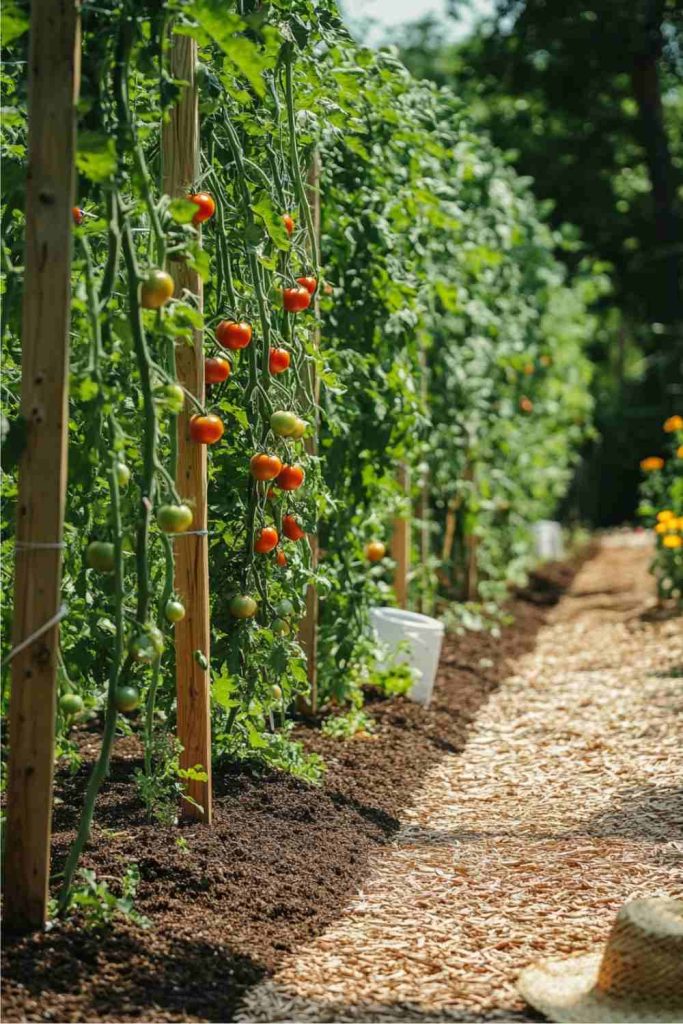
3. Measuring & Mapping Your Space
Gather Accurate Numbers
- Measure property lines, distances to structures, eaves overhang, existing trees’ drip lines, and slopes.
- Mark underground utilities: call before you dig or check local GIS maps. Roots and paths must avoid gas/electric lines by at least 60 cm.
Draft a Scaled Plan
- On graph paper, use a 1 cm = 0.5 m scale. Digital planners (GrowVeg, Gardena, SketchUp) work well, too.
- Duplicate the base map several times to layer alternative designs without erasing original data (sun, wind, soil zones).
4. Defining Garden Zones
Growing Beds
- Keep vegetable beds ≤1.2 m wide—you want to reach the center without stepping on soil.
- Orient rows north–south for even light unless prevailing winds demand east–west to buffer tall crops.
- Group plants by water and nutrient needs (hydrozones). Heavy feeders such as tomatoes sit together, simplifying fertilization.
Access & Utility Zones
- Paths: Minimum 60 cm; 90 cm for wheelbarrows or strollers. Surface with 5 cm coarse wood chips (cheap, permeable).
- Service corridor: 1 m strip along fences for trash bins, compost bays, or storage.
- Gathering space: 2 × 2 m patio squares fit four chairs and a café table. Place where late‑day shade or overhead pergola provides comfort.
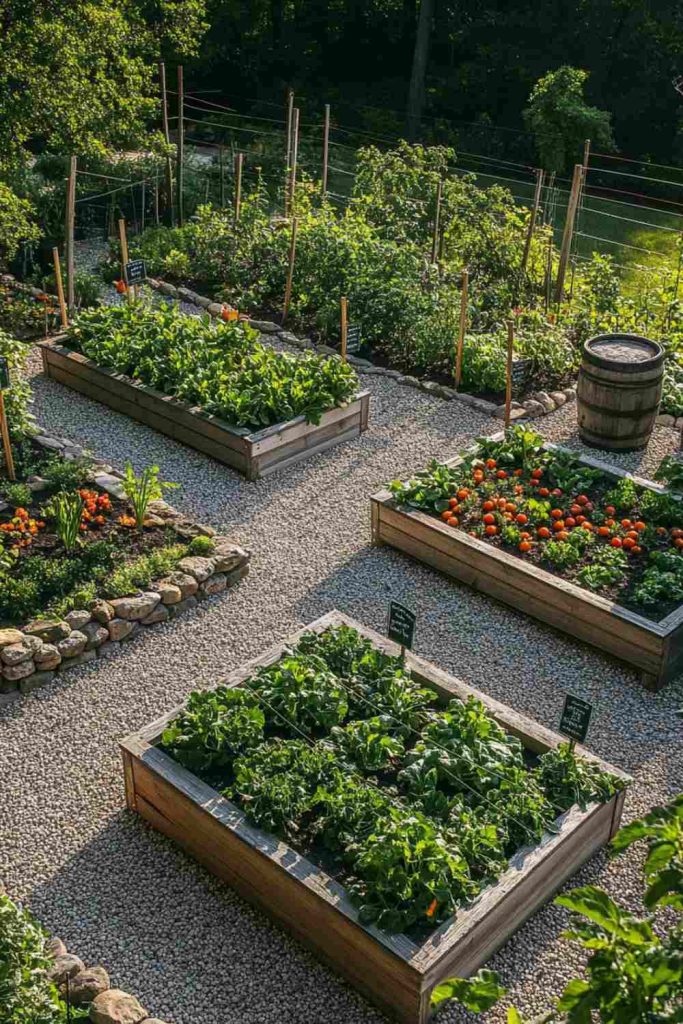
5. Design Principles & Structural Elements
Align Style with Maintenance Tolerance
| Style | Core Features | Weekly Upkeep |
|---|---|---|
| Formal | Axial symmetry, clipped hedges, gravel paths | 1–2 h pruning |
| Cottage/Informal | Meandering beds, dense planting, self‑seeding annuals | 1 h deadheading |
| Modern minimal | Repeated blocks, steel or concrete edging, drought‑tolerant massings | 30 min tidying |
Mix and match: a formal backbone (straight beds) can hold informal drifts of herbs and flowers for a balanced look.
Hardscape & Focal Points
- Raised beds: Cedar or composite lumber, 30–40 cm high, 5 cm cap board for seating.
- Pergolas & trellises: Design to bear 15 kg/m load—enough for mature grapevines or gourds.
- Water features: A 150‑L pre‑formed pond supports dragonflies and frogs; add a solar bubbler to discourage mosquitoes.
- Edging: Steel strips or recycled plastic keep grass out of beds and lend crisp definition.
6. Plant Selection & Layout Strategies
Matching Plants to Site Conditions
- Sun lovers (8+ h) = tomatoes, peppers, zinnias, lavender.
- Partial shade (4–6 h) = leafy greens, hydrangeas, strawberries.
- Full shade (< 4 h) = ferns, hostas, certain native groundcovers (e.g., Pachysandra procumbens).
Spacing & Arrangement
- Follow square‑foot or intensive spacing to maximize harvest. Example for a 1.2 × 2.4 m bed: 32 carrots, 6 lettuce heads, 9 bush beans, and 2 trellised cucumbers—yielding up to 25 kg in 90 days.
- Verticality: Cattle‑panel arches over paths support cucumbers, gourds, and pole beans, doubling ground availability.
- Layering: Combine tall sunflowers (>2 m), mid‑height cosmos (1 m), and ground‑cover nasturtiums (0.2 m) for a pest‑repelling, space‑efficient bouquet bed.
Companion & Succession Planting
| Pairing | Benefit |
|---|---|
| Tomato + basil | Basil emits volatile oils deterring thrips, improves tomato flavor in anecdotal trials. |
| Carrot + radish | Radish germinates quickly, breaks crust, and is harvested before carrots need full space. |
| Corn + pole bean + squash (Three Sisters) | Beans fix nitrogen for corn; squash foliage suppresses weeds and conserves moisture. |
Succession example: spinach in early spring (30 days), followed by bush beans (60 days), then garlic overwintering—all in the same square metre.
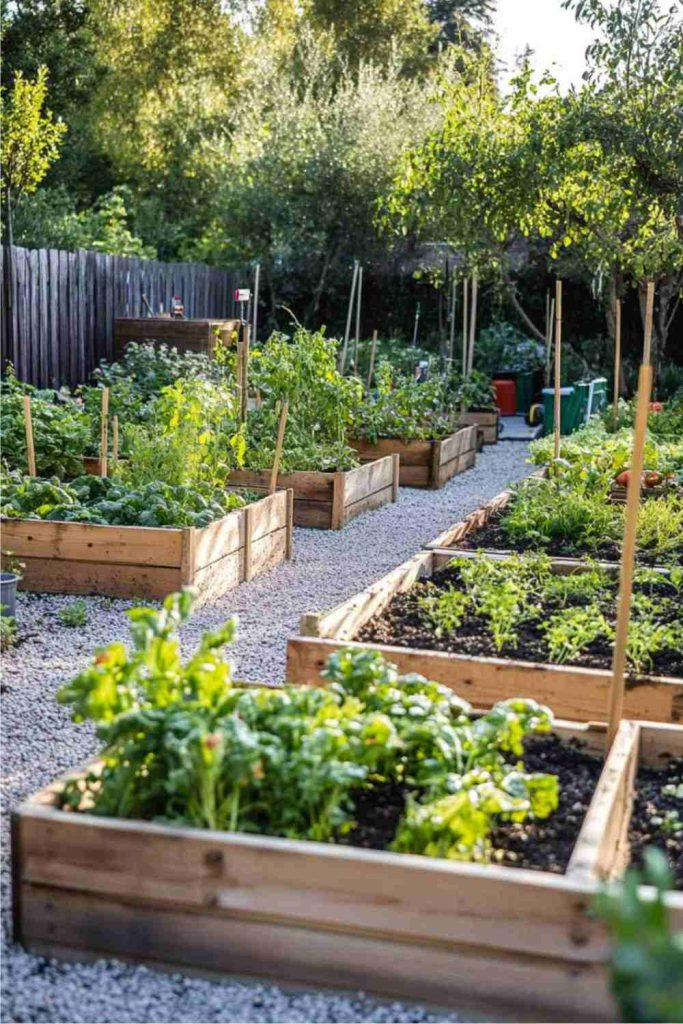
7. Tutorials & Real‑Life Examples
Beginner Raised‑Bed Weekend Build
- Frame: Cut two 3.6 m × 15 cm × 5 cm cedar boards in half; screw into a 1.8 m × 1.8 m square using 8 cm deck screws.
- Site: Level ground, line with cardboard to smother grass.
- Fill: 40 % compost, 40 % screened topsoil, 20 % coarse sand or fine bark.
- Plant: Start with transplants—six tomatoes along the north edge, a center basil row, and trailing nasturtiums in front.
- Yield: 18 kg tomatoes + continuous basil from June–September in USDA Zone 6.
Urban Front‑Yard Lawn Conversion
- Sod removal via manual kick sod‑cutter (rent ~$25/day).
- Install 80 gsm weed fabric; top with 7 cm compost.
- Create two 0.9 × 2 m beds flanking a brick path. Plant salad mix, dwarf tomatoes, and a compact A‑frame cucumber trellis.
- First‑season production: 30 kg cucumbers, 10 kg salad greens—neighborhood buzz included.
Software‑Assisted Planning
- GrowVeg: auto‑generates a sow/harvest calendar and warns when you violate crop rotation rules.
- SketchUp: import Google Earth data for exact lot; draw hardscape with centimeter accuracy—great for HOA submissions.
- Garden Planner Online: database of 1,200 plants; drag‑and‑drop with spacing defaults, then export PDF shopping list.
8. Maintenance & Seasonal Adjustments
Month‑by‑Month Calendar (Temperate Climates)
| Month | Key Tasks |
|---|---|
| February | Order seed, test germination on last year’s stock. |
| March | Start tomatoes/peppers indoors; top‑dress beds with 2 cm compost. |
| April | Set up drip lines before planting—easier when beds are empty. |
| May | Transplant warm‑season crops; mulch with 5 cm straw. |
| June | Side‑dress heavy feeders with organic 5‑1‑1 fish emulsion. |
| July | Install 30 % shade cloth over lettuce if temps > 30 °C. |
| August | Start fall cole crops (kale, broccoli) in cell trays; sow cover crops after early potatoes. |
| September | Plant garlic and overwinter spinach; reduce irrigation as nights cool. |
| October | Remove spent vines, chop‑and‑drop to feed soil; mulch perennials. |
| November | Clean and store tools; drain and coil hoses. |
End‑of‑Season Soil Care
- Chop crops at soil line—roots left in situ decompose, feeding microbes.
- Sow winter rye or oats + peas cover crop if ground will otherwise sit bare; till or crimp in spring.
Yearly Review & Redesign
- Keep a notebook: dates, yields, pest events, weather extremes.
- Rotate families (Solanaceae to Leguminosae, Brassicaceae to Asteraceae) at least every three years to break disease cycles.
- Adjust bed shape or plant palette as trees mature and microclimates shift.
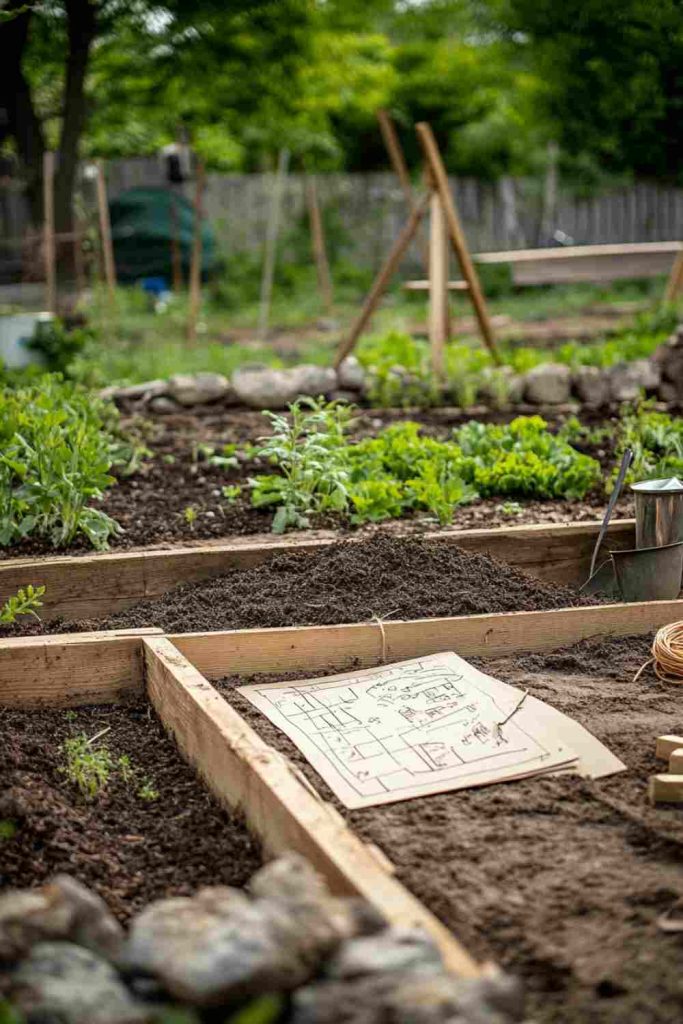
9. Frequently Asked Questions
How big should my first garden be?
Start with about 10 m² (roughly 10′× 10′) or three 1.2 × 2.4 m beds. That delivers ~50–70 kg produce without exceeding two hours per week upkeep.
Can I change my layout mid‑season?
Yes. Containers, grow‑bags, and movable trellises let you plug gaps quickly. Just ensure new placements match sunlight and water needs.
What’s the best way to avoid soil compaction?
Bed widths ≤ 1.2 m, dedicated paths, and ample mulch. Never step inside permanent beds; use a plank if you must.
How can I guarantee good drainage?
Fill beds with a 40/40/20 mix of compost/topsoil/coarse amendment (sand or bark). Ensure beds sit at least 30 cm above grade if your native soil drains poorly.
Do I need raised beds?
Not always. In well‑drained loam you can grow directly in‑ground. Raised beds excel in clay soil, urban lots (imported soil), or for accessibility.
Ready to Put Pencil to Paper?
With clear goals, honest constraints, and a site assessment in hand, you’re equipped to draft a productive, beautiful garden layout that meets your lifestyle and climate head‑on. Every hour spent planning now will save days of frustration later, plus yield fresher salads, more vibrant blooms, and a backyard that truly fits the way you live.
